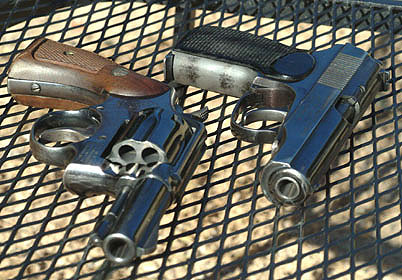
Best Buys In Handguns, Part III: Used/Surplus
By
Aaron Brudenell
Many folks interested in firearms will choose the ones they collect for a number of reasons. Some accumulate products from one gun maker, a specific time or event, or even a single model that may have been copied by numerous manufacturers. Whatever a personís criteria, most of us will find it hard to resist an obvious bargain even if the item is outside the scope of what we normally fancy. This writer is no exception, in fact, I find myself particularly susceptible to a splendid deal at a gun shop or show. Part of my interest, like many others Iím sure, comes from remembering a time when I was younger and much less able to afford the things I wanted most of all. The big advantage in choosing a highly affordable firearm later in oneís collecting is that you tend to have a greater benefit of experience in spotting a truly useful bargain rather than something thatís just cheap.
Say you have $200 and need a handgun for self-defense. The list of new firearms that can be had at that price isnít a long one and many of them are of notorious quality and not to be generally trusted for oneís life if thereís a suitable alternative. I found two very good used ones in this price range, and feel sure others exist (both on this site and elsewhere). I was able to obtain the Smith and Wesson K-frame revolver for just under $200 from a retail store specializing in used and surplus firearms. The Makarov pistol was purchased for around $150 from a licensed dealer at a local gun show; however, Iíve noticed prices on this and similar models slowly drift up to and even slightly beyond the $200 mark in the time since. Hereís the first lesson: conspicuous bargains donít always remain so!

Here is a picture of the 3" Model 10 and the Makarov pistol. Each handgun has its own strong points compared to the other, but both of these do have one thing in common: reliability.
Each of these handguns is a used firearm previously issued to a military or law enforcement agency and thatís a great place to start looking, regardless of how much money you have to hunt for a bargain. The revolver was reportedly one of many issued to a large metropolitan police department in France that probably upgraded to semiautomatic pistols like so many other agencies. Because it was sold abroad and imported back into the US, it bears the dot matrix stamp of the importer. In all other respects, itís a standard K-frame model 10-5, the standard .38 Special successor to the original Military & Police revolver made before World War two. The only unusual feature is the barrel, which is a tapered 3" version unlike the more common 4" variety.
Makarovs were the main sidearm for many of the Soviet block countries for the latter part of the cold war and were produced by Russia, East Germany, China, and in this case, Bulgaria. East German models are widely considered to be best of all, however, I find the Bulgarian model to be in a close 2nd place! Chinese guns can be of inconsistent quality and I donít care for the Russian models, which have an adjustable rear sight (an unnecessary addition of size in my view). The exact history of this Bulgarian Makarov is not known, but the double circled "10" indicates it was made in the state run arsenal and these pistols were most likely used by military and police agencies in that country until sometime after the fall of the iron curtain. As with the revolver, this handgun was imported and bears a similar dot matrix identifier of the importer (the same one as it turns out).
When comparing this pair of options, more differences exist than the usual "revolver" versus "semiautomatic" debate but first Iíd like to consider the commonalties. Both handguns have numerous grip options available and this is very important if one is to select a handgun for their primary defense arm. Most of the Makarov grips are similar in style and shape, however, differences in thickness and texture are significant enough to fit most peopleís needs. I chose the East German style of grip because I have small hands and like the texture. Many friends of mine have opted for the soft rubber Pearce grips that fill larger hands and soften recoil. Like any K-frame Smith and Wesson revolver, there is a virtually endless supply of grips available for the model 10 and the mismatched pair of small factory panels suits my needs adequately.
Both the Makarov and Model 10 have outstanding accuracy and reliability to the point Iíd be hard pressed to distinguish one in either category. The biggest limitation for each in accuracy is their sights and in both cases, I remain satisfied given their role as a rugged self-defense gun. Because each has both single and double-action capability, they can be carried safely and ready to fire quickly or cocked for more precision shots. Recoil for both is also comparableóstandard pressure ammunition for each is mild enough for a novice to master and the +P .38 Specials have the same extra impulse as a few of the heavier recoiling (higher bullet weight) rounds available for the 9x18mm chamber.
Ammunition is the first obvious area of distinction between the two firearms with .38 Special being much more available and diverse in the US than 9x18mm. I often refer to the "Walmart Test" of ammunition availability and clearly youíre more likely to find .38 Specials than 9x18mm wherever you buy your ammunition.
That said, however, the Makarov can be re-barreled quite easily for .380 ACP with minimal cost and Iíve tested several unmodified 9x18mm firearms with .380 ammunition and found surprising reliability with only a slight loss in accuracy. This is not to be considered a recommendationóitís probably comparable to firing .22 Long Rifle cartridges in a .22 Magnum chamber. Problems with certain short bullet designs and the occasional split case should be expected and I think itís better to buy a good supply of surplus ammunition for the long term. But in an emergency or if 9x18mm cartridges become rare the Makarov will not become a paperweight. With the pistol in this article, I tested 9 brands of .380 ammunition and only had problems with Winchester Silvertips and some cast reloaded ammunition, both of which had rather short overall lengths.
The Makarov pistol is notably smaller than the revolver and lighter by about 1/3 pound. These are both key features when considering a handgun for concealed carry self defense. The Makarov also has 50% more firepower with a capacity of 8+1, which compares favorably to a six-shooter. Even though the Makarovís magazine requires a heal release and is slow to reload by modern pistol standards, itís still quicker than the Smith and Wesson and preloaded magazines are easier to manage than revolver speed loaders and strips. I also find the Makarov to be much more natural to point shoot than the revolver although this ultimately amounts to a personal choice and/or a selection of grips. I come to this conclusion with no lack of experience with Smith and Wesson wheel guns that Iíve owned and used without complaint but for me, with the right grips, the Makarov just fits better.
The Smith & Wesson also has its advantages over the Makarov. For starters, both the double and single- action trigger pulls are lighter and a touch smoother. Additionally, itís hard to argue with the simplicity of a double-action revolver. The Makarovís safety is not a bad one: down takes it off while up decocks the hammer and locks the entire action (hammer, trigger, and slide). But with the revolver, as long as the cylinder is fully closed, the gun will function fully with or without ammunition and there are no safeties to forget or worry about. Dry fire practice is always more realistic with a revolver than with a semiautomatic and if firing for effect, the solution to a failure is simply to pull the trigger again. The last and most significant revolver advantage would have to be power.
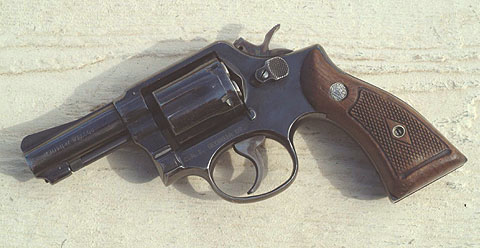
The S&W Model 10 in any of its configurations is a proven design and in a caliber that is probably more potent than the 9x18mm Makarov. Its primary limitations remain but a six-shot capacity and slower reloading.
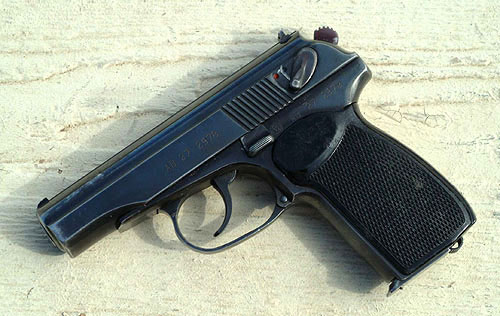
The Makarov holds more shots between reloading than the revolver and despite its magazine release being at the butt of the gun, it is probably quicker than speed strips with the revolver. With speed loaders, the revolver might be just as fast or faster. This would depend upon the skill level of the user. Notice also that even though slide-mounted, the safety on the Makarov works in a natural direction. Down for fire and up for safe.
For self-defense, Iím a big fan of the Speer Gold Dot, which is a good bullet design and in most cases loaded to a healthy power level in factory ammunition. The latest .38 Special + P Gold Dot is a 135 grain bullet that leaves this 3" barrel at around 1000 feet per second. The 9x18mm Gold Dot has the same velocity but is only a 90-grain bullet. Both of these are good options but I would expect the 9x18mm Gold Dot to be less effective by more than a single shade of gray. If one is after heavier weight non-expanding bullets to maximize penetration, good options also exist for both. Fiocchi .38 Special FMJís can be had in 158 grain while the Wolf brand 9x18 JHP is available in the 120-125 grain range and doesnít expand in most media. As with expanding bullets, the edge in the heavier non-expanding projectiles still favors the revolver. (Note: For those interested, there are articles on snub ammunition as well as expansion and comparison tests between 38 Special, 380 ACP and 9x18mm Makarov in "Other Handguns.")
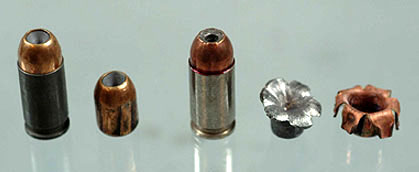
Here are two 9x18mm rounds that were fired into water. The Wolff (left) did not expand while the Silver Bear did. (Bullet and jacket separation is not uncommon when firing into water.)
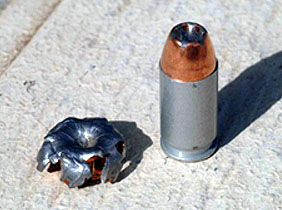
Speer's excellent Gold Dot bullet expands reliably in 9x18mm.
Although both handguns have their respective strong points, neither would leave you inadequately prepared for most uses and for my own purposes, I plan to keep both! The last and final advantage of finding suitable budget guns is that you can avail yourself of more options than you could with less affordable pieces. There are plenty of other affordable used bargains out there and as newer designs replace older ones, one can expect the quality and list of advantages to grow rather than shrink.